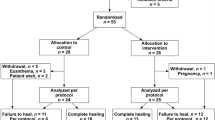Abstract
Purpose
Anal fissure (AF) is a common perianal condition in children. Although adult patients with AF have been treated successfully using diltiazem, it has not been studied in children. The present randomized, prospective, double-blind study assessed the response, side effects, and recurrence of diltiazem.
Methods
Ninety-three children with AF were randomly divided into three groups. Each group received topical ointment. Group GTN received 0.2% glyceryl trinitrate, group L received 10% lidocaine, and group D received 2% diltiazem ointment.
Results
Eighty-two patients completed the 12-month study. At the end of the first 8-week course, the healing rate in group D was significantly higher than that of the other groups (p < 0.0001, χ 2 = 19.82). Nonresponders received a second course of the same treatment. Group D showed significantly higher healing rates than the other groups (p < 0.05, χ 2 = 7.227) at the end of the second 8-week course. The group D recurrence rate was significantly different than that of the other groups (p < 0. 002, χ 2 = 12.79).
Conclusion
Diltiazem application is effective and safe for the treatment of AF in children, and has a low recurrence rate. The smooth dose–concentration curve causes minimal side effects.


Similar content being viewed by others
References
Klosterhalfen B, Vogel P, Rixen H et al (1989) Topography of the inferior rectal artery: a possible cause of chronic, primary anal fissure. Dis Colon Rectum 32:43–52
Poh A, Tan KY, Seow Choen F (2010) Innovations in chronic anal fissure treatment: a systematic review. World J Gastrointest Surg 27:231–241
Tankova L, Yoncheva K, Kovatchki D et al (2009) Topical anal fissure treatment: placebo- controlled of mononitrate and trinitrate therpies. Int J Colorectal Dis 24:461–464
Keshtgar AS, Ward HC, Clayden GS (2009) Transcutaneous needle-free injection of botulinum toxin: a novel treatment of childhood constipation and anal fissure. J Pediatr Surg 44:1791–1798
Amendola S, De Angelis P, Dall’oglio L et al (2003) Combined approach to functional constipation in children. J Pediatr Surg 38:819–823
Medhi B, Rao RS, Prakash A et al (2009) Recent advances in the pharmacotherapy of chronic anal fissure: an update. Asian J Surg 31:154–163
Tander B, Guven A, Demirbag S et al (1999) A prospective, randomized, double-blind, placebo-controlled trial of glyceryl-trinitrate ointment in the treatment of children with anal fissure. J Pediatr Surg 34:1810–1812
Sonmez K, Demirogulları B, Ekingen G et al (2002) Randomized, placebo-controlled treatment of anal fissure by lidocain, EMLA, and GTN in children. J Pediatr Surg 37:1313–1316
Sajid MS, Rimple J, Cheek E et al (2008) The efficacy of diltiazem and glyceryltrinitrate for the medical management of chronic anal fissure: a meta analysis. Int J Colorectal Dis 23:1–6
Nelson RL (2006) Non surgical therapy for anal fissure. Cochrane Database Syst Rev 18(4):CD003431
Knight JS, Birks M, Farouk R (2008) Topical diltiazem ointment in the treatment of chronic anal Fissure. Int J Colorectal Dis 23:1–6
Carapeti EA, Kamm MA, Philips RK (2000) Topical diltiazem and betanachol decrease anal sphincter pressure and heal anal fissures without side effects. Dis Colon Rectum 43:1359–1362
Madalinski MH (2011) Identifying the best therapy for chronic anal fissure. World J Gastrointest Pharmacol Ther 2:9–16
Schouten WR, Briel JW, Auwerda JJ (1994) Relationship between anal pressure and anodermal blood flow. The vascularpathogenesis of anal fissures. Dis Colon Rectum 37(7):664–669
Yakoot M, Abdel SM (2009) Study of efficacy and safety of a new local cream (healer) in the treatment of chronic anal fissure. A prospective, randomized, single-blinde, comparative study. Arq Gastroenterol 46:179–182
Chogle A, Dhroove G, Sztainberg M et al (2010) How relable the Rome III crteria fort he assessment of functional gastrointestinal disorders in children. Am J Gastroenterol 105(12):2697–2701
Farid M, El Nakeeb A, Youssef M et al (2009) Idiopathic hypertensive anal canal: a place of internal sphincterotomy. J Gastrointest Surg 13:1607–1613
Nelson R (2004) A systematic review of medical therapy for anal fissure. Dis Colon Rectum 47:422–431
Tankova L, Yoncheva K, Kovatchki D et al (2009) Topical anal fissure treatment: placebo-controlled of mononitrate and trinitrate therpies. Int J Colorectal Dis 24:461–464
Author information
Authors and Affiliations
Corresponding author
Rights and permissions
About this article
Cite this article
Cevik, M., Boleken, M.E., Koruk, I. et al. A prospective, randomized, double-blind study comparing the efficacy of diltiazem, glyceryl trinitrate, and lidocaine for the treatment of anal fissure in children. Pediatr Surg Int 28, 411–416 (2012). https://doi.org/10.1007/s00383-011-3048-4
Accepted:
Published:
Issue Date:
DOI: https://doi.org/10.1007/s00383-011-3048-4




